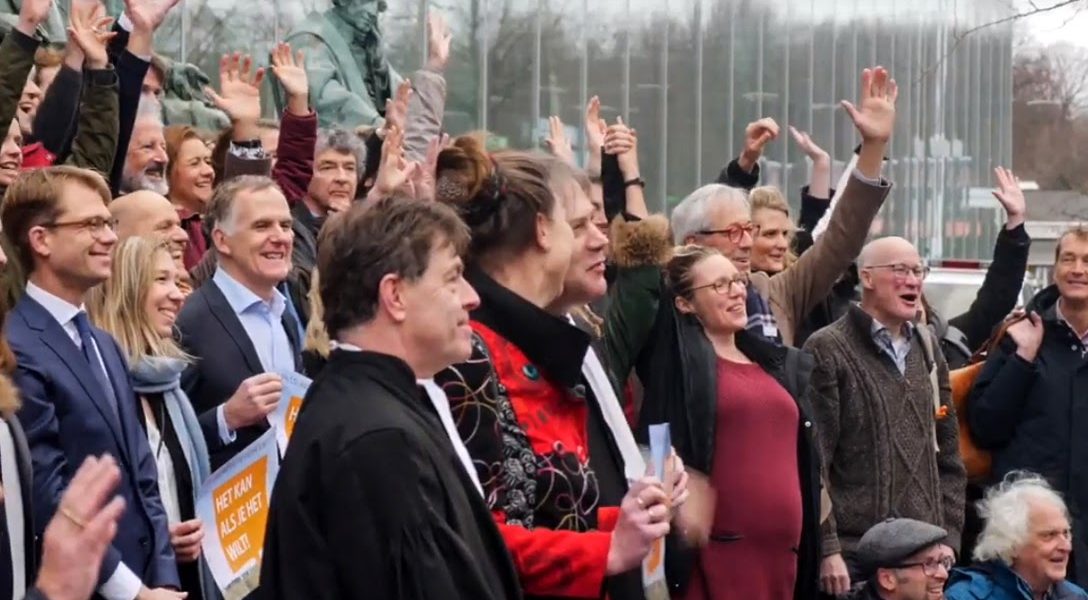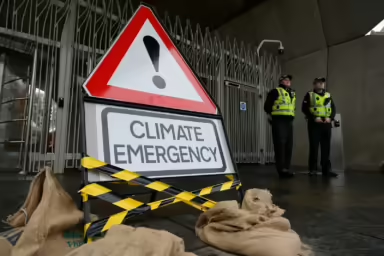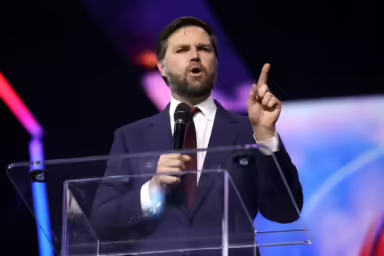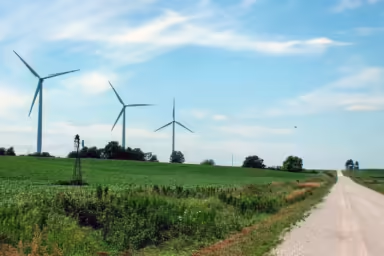A small group of determined Dutch citizens has changed the climate policy of its country through legal action. A similar lawsuit in the US — brought by the “climate kids” — might be headed for the Supreme Court.
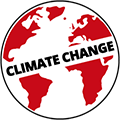
Can ordinary citizens use the courts to force their leaders to fight climate change? In the most revolutionary climate ruling to date, the Supreme Court of the Netherlands delivered an emphatic “yes” on December 20, upholding a court order forcing the Dutch government to cut national carbon emissions.
In the wake of the decision, a group of children and young people in the US is hoping to gain traction in a similar legal battle (Juliana v. United States) as they claim the right to live in the same climate as previous generations.
Some 886 Dutch citizens — supported by the environmental group Urgenda — started their court battle against the government with a 2013 court summons for “knowingly contributing” to global warming and endangering their lives. They won their case, Urgenda v. the State of the Netherlands, in 2015. Between 2015 and 2019, while the Dutch government tried to have a higher court overturn the landmark Urgenda ruling, global emissions of CO2 grew by 20 percent. They were the five hottest years ever recorded.
The 2015 Urgenda decision cited the scientific consensus on global warming and ordered the Dutch government to cut carbon emissions by at least 25 percent (below 1990 levels). It was based on the UN’s Intergovernmental Panel on Climate Change (IPCC) recommendation of a 25–40 percent reduction by developed countries to avoid a critical 2°C rise in global temperatures.
In upholding the unprecedented decision, the Dutch Supreme Court said its judgement was based on the universal duty to refrain from doing harm (Tort law), the European Convention on Human Rights — Articles 2 and 8, the right to life and the right to respect for private and family life — and the UN Climate Convention. The ruling that people have a fundamental right to protection from climate change victory could resonate profoundly in lawsuits over carbon emissions in many other countries.
Having exhausted all appeals, the Dutch government is expected to struggle to meet the emissions deadline. It has already closed one of the nation’s five coal-fired power plants and launched new subsidies for renewable energy. It will reduce the speed limit on highways from 130 kph (80 mph) to 100 kph (62 mph).
Time to Panic
Roger Cox, the attorney who represented Urgenda in its initial proceeding against the Dutch government in 2013, told WhoWhatWhy he believes the courts are our last chance because everything else has failed. The Netherlands is one of at least 28 countries where lawsuits seek to hold either governments — or fossil fuel companies — accountable for the effects of climate change.
“I hope this win, from a legal perspective, will create leverage in other cases around the world, not only in cases against countries’ governments but also oil majors,” said Cox, who is now leading Friends of the Earth’s case against Shell Oil.
Ironically, the fact that a quarter of the Netherlands is below sea level does not seem to have played an important role in the Dutch court’s deliberations.
According to Cox, the decision “is more about the global effects, and sea level rise is only one of them, along with the destruction of whole ecosystems, the melting of glaciers and the danger to food supply from extreme weather events. I think what worries the courts and our judges is the danger of tipping points that will irreversibly create dangers we can do nothing about anymore. The danger is there if we don’t reduce emissions ambitiously enough.”
In the absence of laws and policies to reduce carbon emissions, climate scientists are bluntly warning that it is time to panic. The latest United Nations climate report calls for “radical transformations” because planet-warming emissions, if not cut radically over the next decade (7.6 percent per year, something no country has ever achieved), will cause mass extinctions and make parts of the planet uninhabitable. If a serious effort had begun in 2010, it says, the cuts required to keep global warming below 2°C and 1.5°C, respectively, would only have been 0.7 and 3.3 percent per year.
So far, commitments from states to cut carbon emissions have come in the form of international treaties, leading to decades of broken promises. The international community agreed, in the 2015 Paris climate accord, to hold global warming to “well below” 2°C (3.6°F) compared with pre-industrial levels. But the current rate of warming will raise the earth’s temperature by almost twice as much.
The Dutch Supreme Court shocker comes on the heels of failed negotiations on collective climate action at the latest UN Climate Summit (COP 25) in Madrid.
“The point of no return is no longer over the horizon,” said UN secretary general António Guterrez. “It is in sight and hurtling toward us.”
He admitted that, after 25-plus years of negotiations, world leaders still do not have the “political will” to stop climate chaos.

A Legal Youthquake
The mass resistance by young people that took off last year against government-sanctioned climate change caught the world by surprise. A global wave of school strikes culminated in the largest youth-led demonstrations in history during the week of September 20–27. Millions of people took to the streets in 150 countries. But it is as if “nothing has happened,” according to teenage climate activist Greta Thunberg. “The crisis is still being ignored by those in power.”
With Thunberg, practically unknown last year, making the cover of Time magazine — the youngest Time “person of the year” ever — and the emergence of groups like Fridays for Future, the Sunrise Movement, Extinction Rebellion Youth, Zero Hour, and Youth Vs. Apocalypse, climate change suddenly seems to be about intergenerational conflict.
But young people around the world have been confronting their governments for several years now — in court. Many of them were inspired by the landmark Urgenda case and/or Juliana v. United States, a federal lawsuit filed in 2015 in Eugene, OR, by a nonprofit specializing in climate litigation, Our Children’s Trust. The 21 young plaintiffs, aged 8 to 19 at the time, are often referred to as the “climate kids.”
Kids are suing their governments for ruining the planet in Belgium, Ireland, New Zealand, Norway, and Switzerland. In 2016, a seven-year-old girl sued the government of Pakistan over climate change; the following year, Ridhima Pandey, who is now 11, did the same thing in neighboring India.
A group of Portuguese children (aged 8 to 18) from a region devastated by forest fires in 2017 is launching a crowdfunded class action suit in the European Court of Human Rights against 47 “major emitters” (including the United Kingdom, Ireland, Germany, and France) that have signed the European Convention on Human Rights.
“What is the purpose of a government if not to protect the lives and safety of its citizens?” asks a group of young people from Quebec in its class action lawsuit against the government of Canada, on behalf of all the citizens of Quebec under the age of 35.
In Colombia, last spring, the country’s Supreme Court ruled in favor of the unborn, saying they are entitled to the same environmental conditions currently available to everybody else. The decision came in response to a lawsuit by a group of 25 children and youth arguing that deforestation in the Amazon region, the main source of greenhouse gas emissions in the country, violated their rights. The judges gave the government four months to present a plan to reduce deforestation. The Colombian government has thus far ignored the court order.
On September 23, Thunberg and 15 other young people from around the world brought a legal complaint about climate change to the United Nations against five of the world’s major carbon polluters — Argentina, Brazil, France, Germany, and Turkey — for violating the UN Convention on the Rights of the Child, which states that children have the right to life, health, and peace. Suing the United States under the international treaty is not an option because it is the only country in the world that has not ratified it.
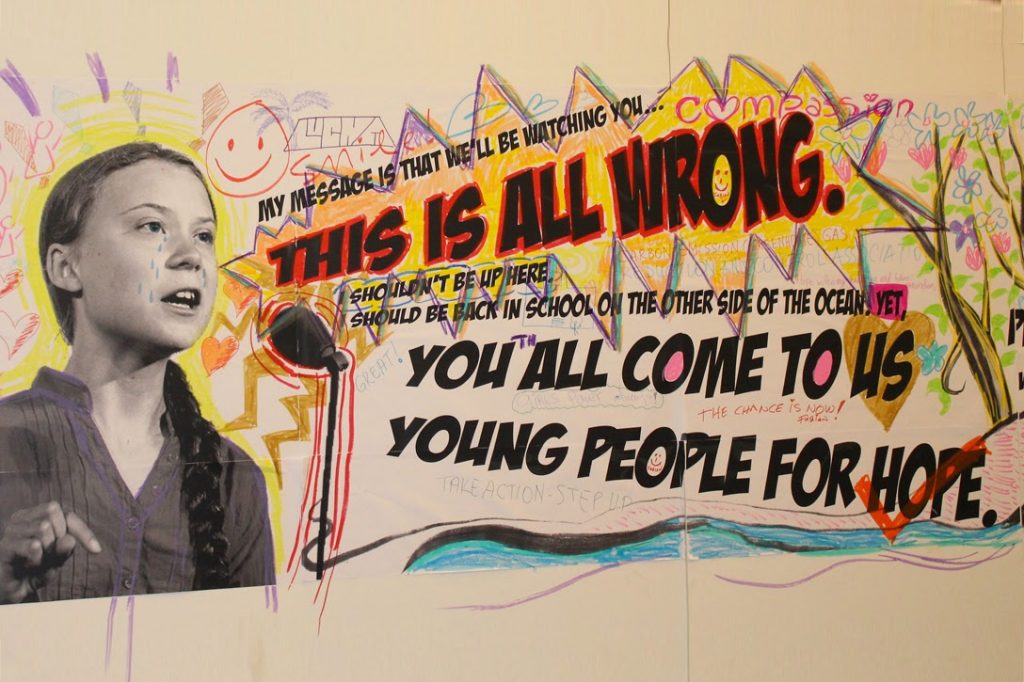
Youth v. Gov
Among all climate change lawsuits, Juliana v. United States (also known as Youth v. Gov) is arguably the most important because it is the one with the most emissions at stake.
Simple climate math is the reason. The US has, over many decades, put more C02 into the earth’s atmosphere than any other nation (though China is now the largest emitter of carbon). As the world’s largest producer of oil and gas, the US is at the heart of Global Oil and Gas sector plans to invest $1.4 trillion in new extraction projects over the next five years. A staggering “85 percent of the expanded production is slated to come from the United States and Canada.”
The climate kids first sued President Barack Obama and then President Donald Trump for violating their constitutional rights by failing to protect them from climate change, based on the “public trust” doctrine, seeking to apply it for the first time to the atmosphere. Their current list of defendants includes federal agencies like the Environmental Protection Agency, the Department of Energy, and the Office of Science and Technology Policy.
To a non-lawyer, it might be taken for granted that kids have a right to a livable climate. But the legal implications of the young plaintiffs’ demands are radical. To get there, the federal government would have to deploy the resources of half a dozen agencies come up with a “climate recovery” strategy, under which “the legislative system and the executive system have to work together in order to come up with a plan that would draw down carbon emissions to a point that’s sustainable for human life.”
The Juliana case is seen by many as having parallels with Brown v. Board of Education, in which the Court ruled that segregation in public schools was unconstitutional and ordered all federal, state, and local districts to desegregate.
When government and fossil fuel industry lawyers sought to have the Juliana case dismissed, US Magistrate Judge Thomas Coffin cited the example of Urgenda v. the State of the Netherlands. He concluded that it is time to “evaluate the constitutional parameters of the action or inaction taken by the government.”
In November 2016, a federal judge, US District Judge Ann Aiken, denied the government’s lawyers’ motion to dismiss the case and set a trial date. In her decision, Aiken wrote what is regarded as the first legal recognition in the US of a right to a healthy climate — “I have no doubt that the right to a climate system capable of sustaining human life is fundamental to a free and ordered society.”
The Trump administration has appealed Aiken’s decision three times to the Ninth Circuit Court of Appeal and twice to the Supreme Court. Government lawyers argue that Juliana v. US would cause “irreparable harm” to the United States if it goes to trial. Oral arguments were last heard on June 4 before the Ninth Circuit, in Portland, OR.

That court must also decide on the climate kids’ request for a preliminary injunction that would actually force the Trump administration to stop approving coal mining, offshore oil drilling, and new fossil fuel infrastructure on public lands in order to “keep the harm from severely worsening while the legal process is in play.”
“We may have the wrong Congress and the wrong president. That’s occurred from time to time over history,” said US Court of Appeals Judge Andrew Hurwitz, during the hearing, which was livestreamed on YouTube. He pondered out loud whether to dismiss Juliana v. US or let it go to trial: “The real question for us is whether we get to intervene because of that.”
How the Hell Did We Get Here?
Julie Olson, the lead counsel of Juliana v. United States and founder of Our Children’s Trust, has collected tens of thousands of pages of evidence, including memos revealing that the US government was warned about the causes and dangers of climate change 50 years ago.
Trump — whose administration is scrubbing the words “climate change” from government documents and websites — is only the latest in a long line of US presidents who have permitted, facilitated, and subsidized a vast share of the world’s cumulative carbon emissions.
The lawsuit documents how scientists and experts on climate and atmosphere have repeatedly briefed president after president, Democrat and Republican, on “the unusually dangerous risks of harm to human life, liberty, and property.” A 1965 study written by President Lyndon B. Johnson’s science advisory committee predicted rising sea levels and noted that “man is unwittingly conducting a vast geographic experiment.”
In 1969, Daniel Patrick Moynihan, a Democrat serving as an advisor in the Nixon administration, submitted a memo summing up “the carbon dioxide problem.” “Goodbye New York,” he wrote, citing a projected 10-foot rise in sea levels, “Goodbye Washington, for that matter.”
Each administration ignored the warnings and continued to subsidize the fossil fuel industry. Before Trump came into office, under Obama, subsidies were already at $649 billion a year (nearly 10 times more than Congress spends on education) according to the International Monetary Fund (IMF). That figure included direct transfers of taxpayer money to fossil fuel companies as well as the indirect costs of carbon pollution. The IMF concluded that simply ending fossil fuel subsidies globally in 2015 would have already lowered carbon emissions by 28 percent. Deaths from fossil fuel air pollution would have fallen by nearly half.
As a result of Juliana v. United States, the Trump administration has been forced, as defendants, to acknowledge in court filings what they won’t admit publicly: that climate change is real — a real threat to national security, the economy and Americans’ lives and safety. “They admit that the government has known for over 50 years that burning fossil fuels would cause climate change,” Olson, told 60 minutes. “They do not dispute any of those facts.”
Congress after Congress has also failed to tackle climate change. The chances of ambitious climate legislation today, with Republicans holding the Senate, are essentially nil. The first climate bill in Congress in 10 years — the Climate Action Now Act, which would continue US participation in the international Paris Climate Accord, was passed by the House in May but now lies in Senate Majority Leader Mitch McConnell’s (R-KY) “legislative graveyard.”
Olson sees the case, which has carried the day so far, against all expectations, in the light of other moments in US history when the courts intervened to overcome the paralysis of the legislative and executive branches.
“If we look back on the twentieth century, we can see that race and sex discrimination were the constitutional questions of that era,” she said, in her summing up before the Ninth Circuit Court of Appeals on June 4. “And when our great-grandchildren look back at the twenty-first century, they will see that government-sanctioned climate destruction was the constitutional issue of this century.”
‘Raw Meat’
Some legal experts are convinced that the climate kids’ “trial of the century” will never take place at all. The case for and against its dismissal is being heard in the Ninth Circuit Court of Appeals — for the third time.
Just 10 days before Juliana v. United States was originally scheduled to go to trial in October 2018, Chief Justice John Roberts hit the pause button. This was a rare, almost unprecedented pretrial intervention.
In July, less than six months earlier, Supreme Court Justice Anthony Kennedy, in almost his last act before retiring, had refused to stop the trial from going ahead (though expressing concerns about its scope).
Washington State Judge Rules Against Kids in Climate Change Lawsuit
What had changed? Kennedy was replaced by Brett Kavanaugh. Over the years, Kennedy was a key swing vote on some environmental issues. He was the fifth vote in the 2007 Supreme Court decision in Massachusetts v. Environmental Protection Agency, which ruled the EPA has the authority to regulate carbon dioxide emissions under the Clean Air Act. There are fears now that the new Supreme Court with Kavanaugh on the bench will vote 5–4 to overturn that decision.
The Supreme Court’s unexpected intervention ahead of the Juliana v. US trial was “incredibly ominous,” said Kassie Siegel, director of the Climate Law Institute, in an interview. The Trump administration believes that they have five justices on the Supreme Court that will vote for them no matter what, and the litigation strategy is always about trying to get there. The Urgenda case really highlights just how out of step the current US Supreme Court and Trump administration are with the international community.”
WhoWhatWhy spoke to Philip Gregory, co-counsel for the 21 young plaintiffs, who said, “If the Ninth Circuit panel rules in favor of the plaintiffs in Juliana, we believe, given its prior history the Department of Justice will again seek Supreme Court review.” According to him, “The federal government is scared to put climate science on trial.”
Harvard law professor Richard Lazarus speculates the Ninth Circuit Court of Appeals’ judges are being given one last chance to dismiss Juliana v. US before the Supreme Court’s new conservative majority steps in. “If they rule in favor of the plaintiffs, the Supreme Court is going to take the case … This could be raw meat for a lot of justices on the [Supreme] Court, and it won’t be a pretty sight.”
Related front page panorama photo credit: Adapted by WhoWhatWhy from Alfred Grupstra / Flickr.
